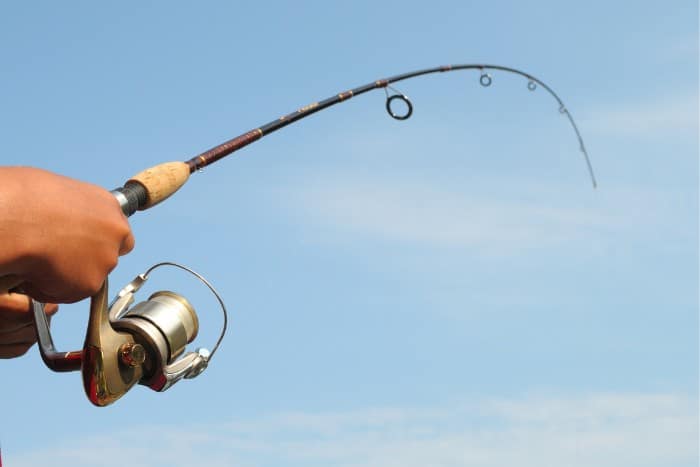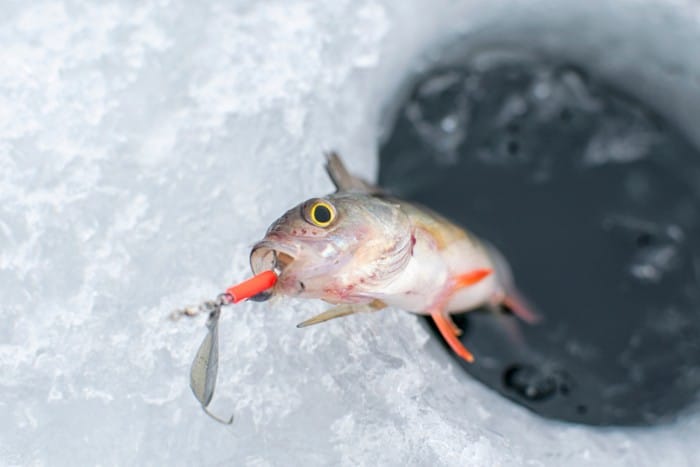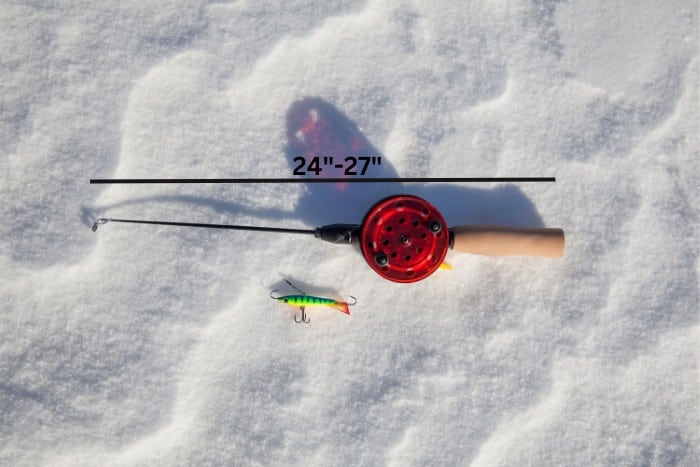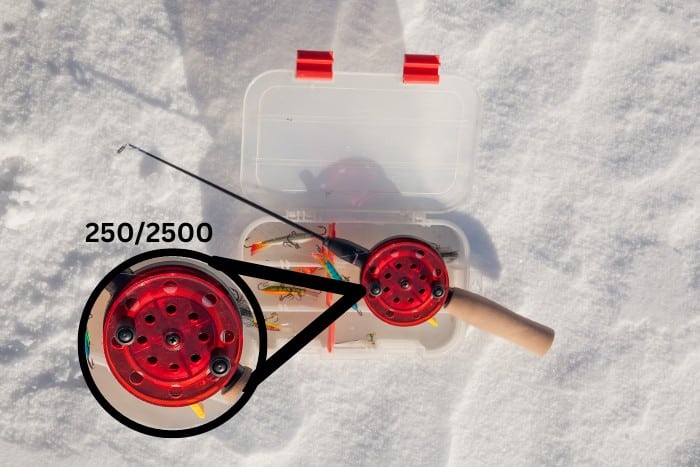One of the first things many anglers notice when going from traditional rod and reel fishing to ice fishing is the difference in the size of the fishing rods used. Standard fishing rods are around six to eight feet, but ice fishing rods are around 2.5 feet.
Ice fishing rods are short simply because shorter rods are more sensitive, and the benefits of long fishing rods are not needed. Ice fishing often takes place indoors where space is at a premium, and a shorter rod helps control fish when you bring them in while keeping your line away from the ice.
Below we’ll cover some benefits of a short rod while ice fishing and what makes a good ice fishing rod.
Why Are Ice Fishing Rods So Much Shorter Than Standard Rods?
Ice fishing rods come in sizes from as small as 18” to large rods in the 48” range. Two-and-a-half to three-foot rods are the most commonly used, much shorter than standard fishing rods.
For fair-weather fishing, fishing rods can be anywhere from six feet to twelve feet, give or take a couple of feet on either end for the outliers. But why is there such a difference?
1. A Brief History Of Ice Fishing Rods
Before examining some of the reasons that ice fishing rods benefit from being so small, it’s important to look back at the sport of ice fishing and how it developed to where it is now.
Ice fishing was originally a way for Indigenous people to spearfish while the ice was frozen over.
Fast forward a couple of thousand years, and in the late 1800s, ice fishing became a popular hobby across the cold states of the North and Midwest.
At this time, anglers had two options: go ice fishing with a regular rod and reel, or use a line tied to the end of a short stick.
Many anglers used a stick since they found a longer fishing rod cumbersome; thus, a need was exposed in the ice fishing market.
As ice huts and shanties became more prevalent, the demand for short ice fishing rods increased, and manufacturers continued to improve on the designs until we got the variety of ice fishing rods that we enjoy today.

2. Shorter Rods Offer More Sensitivity
It’s no secret that fish are much more sluggish in cold water than in warm water. Their lack of energy is because fish are cold-blooded, meaning they cannot regulate their body temperature.
Because fish are at the mercy of the temperature of the water, cold water slows down their metabolism, limiting how well they can digest food and get their energy from it.
Cold water means fish need less food and have less energy which is an important survival mechanism.
All this is to say that when the water is near freezing in winter, fish won’t take the bait with as much force as they will in summer.
A light bite from the fish can make it difficult to detect, so fishermen want a sensitive fishing rod for those situations.
The smaller the species you plan on targeting, the more you’ll benefit from a sensitive fishing rod. Panfish, smelt, and perch are all commonly targeted species that can lack a punch while ice fishing.
3. Longer Rods Are Better For Casting
Long fishing rods are great for casting a far distance from shore. With seven-foot rods, the average angler could cast 30-40 yards, while using a 12-foot surf rod, one might achieve well over 100 yards.
For ice fishing, there is no casting.
All the extra leverage that comes with using a longer fishing rod to get your bait out to where the fish are is useless when you can stand above a hole in the ice and drop your bait straight down.
Of course, there are a few other benefits when fishing with a longer rod, even when ice fishing, but that’ll be covered later in this article.
When ice fishing, a short ice fishing rod will provide all the power and control that they’ll need to catch most fish.
4. Ice Fishing Rods Are Better Suited To Use Indoors
Hard-sided ice shanties and flip-over ice huts provide well-needed protection from the elements at the cost of one crucial resource: space.
As a result, if you want to utilize the space inside your shelter efficiently, a short ice fishing rod will help.
Ice fishing tents don’t have enough space for using a fishing rod over three feet, and any more than that, you risk bumping into things, getting tangled, or general discomfort.
Short rods are especially relevant if more than one person is fishing in an ice fishing shelter at once.
As an added benefit of the small size of ice fishing rods, they are incredibly portable, weighing no more than a couple of pounds and fitting almost anywhere.
An angler might need to carry or pull their gear a long distance when ice fishing, and every pound saved can help.
5. Cold Water Makes Fish Less Active
As mentioned above, fish have less energy when the water is cold. Not only does that make them bite lighter, but it also makes them a bit easier to fight and bring them in.
Longer fishing rods, for several reasons, do a better job of fighting fish, which is less critical during ice fishing.
Longer rods being better for fighting fish is also only true for fish up to 100 pounds or so, and after that, shorter rods reign king.
Fishing in summer for bass, walleye, pike, or similarly sized fish, the longer rods help provide absorption for those headshakes trying to lose the hook, helping bring the fish in.
When ice fishing, the fish cannot put quite so much effort into trying to shake free of the hook.
That’s not to say that large fish won’t fight much, but compared to warm water, you don’t need as much help from the rod to bring them in.

6. The Ice Poses A Challenge When Ice Fishing
One of the challenges of ice fishing that’s not prevalent when fair-weather fishing is the ice. The ice poses many threats to your fishing line and can cause it to break, losing that massive fish you were reeling in.
When ice fishing, you want to bring the fish as straight up as possible, keeping your line away from the edges of the ice.
Trying to control where the line is is much easier with a three-foot rod than with a seven-foot rod.
While the ice itself isn’t the one cutting the lines, a combination of cold temperatures and the friction of the line against the ice can cause the monofilament or fluorocarbon line to break prematurely.
7. Standard Size Fishing Poles Can Still Be Used When Ice Fishing
Shorter rods definitely perform better for ice fishing than standard-sized rods, but that’s not to say that you can’t use longer rods for ice fishing.
In fact, there are some cases where you’re better off using a five or six-foot rod than using a standard ice fishing rod.
One of these cases is when targeting monster-sized fish weighing 30+ pounds. These big fish can put up a good fight despite the winter conditions, and a longer rod is more forgiving in these scenarios.
Longer fishing rods offer a greater area to absorb rough headshakes and are typically rated for heavier fish. This combination makes larger rods popular for ice fishing among those chasing trophy fish.
Always check local rules and regulations, but most places will allow you to use standard fishing rods for ice fishing.
If you want to try ice fishing before investing in the gear, you can use your 5 to 6-foot summer fishing rod.
While some experienced anglers might look at you funny, using a normal fishing rod can be a great way to test the waters.
Sitting in the cold hoping to catch a fish is not for everyone, so giving it a test run before investing further can be a great option.
What Makes A Good Ice Fishing Rod? – Size Matters But So Do Other Things
While ice fishing rods are a lot shorter than their summer-use counterparts, there are a few other things to look for when picking a new rod for ice fishing.
Choosing the correct length for you and understanding a few characteristics of fishing rods can help you make an informed choice.
1. The Length Of The Ice Fishing Rod
Ice fishing rods come in lengths as short as 18” and up to 36” or so. If you’re looking to buy your first one, one in the 24”-27” inch range will be best for you in most situations.
A rod this length is comfortable for indoor use while still long enough to offer a bit more flexibility to bring in the fish.
It’ll also let you sit reasonably close to the ice fishing hole so that you can keep your line vertical in the water.
Another thing to consider is that all else being equal, the longer the rod, the heavier it will be. Ice fishing rods are typically not that heavy, but a few extra ounces can cause fatigue over long periods.

2. Power And Action Of The Ice Fishing Rod
The power and action of ice fishing rods are important aspects, impacting what fish they do best with and what methods work best with them.
To choose the right rod for you, start by thinking about what species you want to target and what methods to do so.
The power of a fishing rod refers to how much force is needed to bend the fishing rod.
Light or medium rods are a good choice if you don’t know what species you’ll be targeting and are looking for a versatile option.
Ultra-light is the best option for tiny panfish, while heavy rods work better for large pike.
Action is the classification of how much the rod tip bends before it meets the backbone, the part of the rod that doesn’t bend.
Extra fast means very little of the rod bends, while slow means about half of the rod will bend.
Fast action rods are commonly used in ice fishing and are a good choice if you want to have plenty of sensitivity and provide fast hooksets and plenty of backbone to fight big fish.
Moderate and slow action rods offer more forgiveness if you’re prone to hitting the hook aggressively or jigging with a minnow.
3. Location Will Impact Rod Choice
Depending on where you are fishing, one type of fishing rod will serve you better than others.
For example, shorter and lighter fishing rods are easier to transport if you need to pull your equipment a long way.
If you are fishing inside a tent or shanty, shorter ice fishing rods will offer better use of the limited space.
The fish in the body of water you are fishing in will also impact what rod works for you.
If you’re in an area with lots of small panfish, an ultralight rod will be better than fishing for large lake trout, where a beefier rod might be ideal.
4. Material Choice
The material that makes up the bulk of the fishing rod, also called the rod blank, can impact the rod’s performance.
The difference in materials will probably be hard to notice for new anglers, but experienced anglers will have firm opinions on blank materials.
Fiberglass blanks are the most durable at the cost of being heavier than graphite. Graphite blanks, on the other hand, are lighter and incredibly sensitive but are more prone to getting damaged and failing.
Composite blends are somewhere in between and can offer different benefits based on their composition. Other materials are available to choose from but are less common than those three.
The material that makes up the rod handle is also a personal preference, as some fishermen prefer to use cork, some prefer foam, and some prefer other options.
The handle’s material will have little effect on the rod’s performance, so choose your favorite.
5. Quality Reel Designs
One area that can make a big difference when out ice fishing is the construction of the reel you use.
Small reels with a spool in the 250/2500 or smaller size are suitable for ice fishing because you don’t need many lines spooled up.
Spinning reels are typically the best for ice fishing since their open design is easy to maintain compared to push-button reels, and the open design helps them perform well in freezing temperatures.
Simple inline reels are also popular for ice fishing and prevent dreaded line twist, which can cause tangles in the line. Some people also find that inline reels do better in sub-freezing temperatures.
Reels marketed towards ice fishing and ice fishing-specific lines should be used to prevent ice-ups in your reel, causing jams and other issues and making the fishing more difficult.
You can read our guide on the best ice fishing reels for buying your next one.

Thanks For Reading!
More space efficient, and ice fishing rods simply do not need to be very long. A combination of lethargic fish, limited space, and a need to sit close to the hole in the ice make smaller rods perfect for ice fishing.
Small ice fishing rods result from necessity and preference, thanks to ice fishing huts and the unique challenges of ice fishing compared to fair-weather fishing.
A small rod provides needed sensitivity and excellent portability and is perfect for the task.
